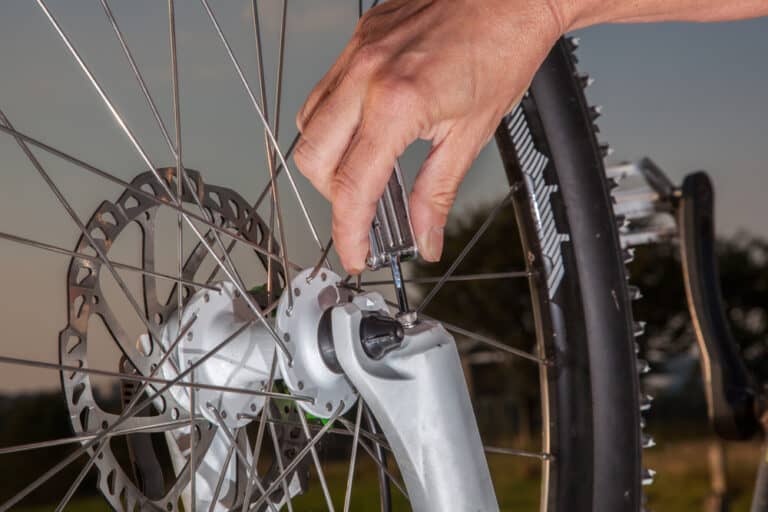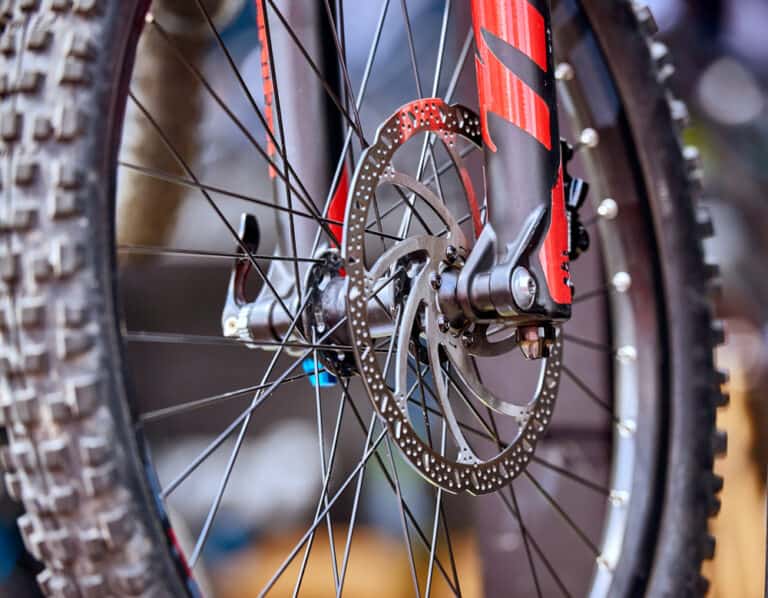Can You Use MTB Hubs On Road Bike?

When you start to ride on different terrains, you will quickly learn that road bikes are only meant to be on flat and tarred roads. If you own an expensive bike, you may wonder if you could attach mountain bike (MTB) hubs onto your lightweight road bike frame.
You can fit MTB hubs on some road bikes, except CX frames and specialized frames made for the spacing of road hubs. MTB hubs don’t fit on some road bikes because the dropout spacing is different, causing the hub not to fit and the bike’s forks too close together.
While it can be tempting to get your road bike fitted with these new hubs that promise to give you the ability to traverse across mountains, there are limitations. Many people find owning several different bikes is much easier and safer than having one bike that works for everything.
What Is The Difference Between Road And MTB Hubs?
All MTB hubs are 135mm in width and have a thicker thru-axle, providing more bike control over rougher terrain. While some road bikes doe has 135mm hub widths, they are more likely to be 130mm in width and have thinner thru-axles to provide easier pedaling.
The MTB hubs are also made to withstand shocking pressure, not just the pressure applied by going in a straight line over tarred roads. This often means they are reinforced and made to withstand the heavy impacts you will experience when riding, making them heavier to ensure they are strong.
We have seen that the hubs used on road bikes are usually thinner and much more lightweight, helping to reduce weight. This is often because when using a normal road bike, you will be doing marathons or long-distance biking, where the bike’s weight can have a drastic effect.
What Do You Need To Do To Fit MTB Hubs On A Road Bike?
You need to measure the width of your current road bike hubs and ensure they are the same as the MTB hubs you plan to use. It is also important to measure the forks on your bike, ensuring they are wide and long enough to fit over the wider and often longer tires used with MTB hubs.
If the bike you use has the right spacing, you can remove the old wheel and fit the new one onto the bike. However, if there is not enough spacing on the frame to accommodate the hub width or the total size of the wheel, then you will have to get a different bike frame entirely.
You should not try to bend or drill out the bike frame, as this can irreparably damage or even weaken it without you knowing. Causing a catastrophic failure when you need the frame to be as tough as possible, maybe even while you are nearing the finish line.
Why Are The Hub Sizes Different?
There are several reasons why the hub sizes of road and mountain bikes are different, with many people assuming that it is just cosmetic. In reality, these bike hubs are different species because they provide different features and strengths needed for the bikes.
If you understand how these hubs are different, you will know where to use them when the time comes. Many assume that all bike hubs are the same causing issues when they are far from shops and their bike suffers a catastrophic failure.
Amount Of Force
Mountain bikes have to handle a significantly higher amount of force than road bikes have to endure, often being driven off small hills. The MTB hubs are made from heavier and stronger materials to ensure they do not crack when undergoing these heavy pressures.
Road bikes often have to suffer much fewer physical forces and be as efficient as possible to ensure easier long-distance travel. You may find that road bike hubs are much thinner and made of lightweight material that allows you to travel for much longer.
Type Of Roads
A road bike is meant to be used on pavement and tarred roads that are as smooth as possible, which means the hubs can be well-balanced and only need to handle slight shocks. This means they often have much smoother gear changes and are not so well protected from rocks and dust.
MTB hubs are meant to be used on bikes that may have to go over several different surfaces within a few minutes. Often mountain bike trails will go from tarred roads, sandy pits, wooded trails, through mud, and small streams, and then back onto tarred roads, which means they need to be able to handle all conditions.
How The Bike Is Used
The basic difference in how each bike is used comes down to the type of sports each one will be used for. A mountain bike is used for shorter distances with high-impact situations, while road bikes are used for longer distances that require smoother movement of the hub.
We must mention that road bike hubs can handle many of the same impacts but will not be able to handle them within longer time frames. While mountain bikes can be used on roads, they become heavy and hard to peddle as the hubs and wheels cause more resistance over time.
Efficiency Of The Wheels
MTB hubs are plenty efficient but require more initial power to move the bike, owing to their weight and overall size. A road bike hub, when compared, can practically feel like it requires almost no power at all to start moving, often feeling like the bike wants to move forward.
Both hubs have internal bearings to ensure you can easily and comfortably peddle the bike as needed over almost any distance. It is important to consider what type of distances you will be traveling because of this, ensuring you don’t get tired because your hubs and wheels are the wrong types.

Are Bike Hubs Universal?
Most bike hubs are universal, with MTB hubs reaching only 135mm, and most road bikes using 135mm hubs to ensure consistency. When moving up to enthusiast bikes, you may find that the hubs become thicker or thinner depending on the kind of bike that you are buying.
The bikes you may find at a supermarket will have the standard 135mm hubs and wheel forks meant to be used with standard mountain bike wheels. If you buy a bike from a specialist store, you must specify what you are using the bike for to ensure the best ride.
We recommend talking to an expert to ensure that you can easily and comfortably have the bike with all the necessary features. As the bike hubs change size and type, they also become much more expensive, often becoming too expensive to replace with new ones casually.
Are Expensive Bike Hubs Worth It?
If you are only casually biking for fitness, we recommend getting one good set of bike hubs that is affordable; these will outlast many parts of your bike. If you are going to be marathoning or hardcore mountain bike trail riding, we recommend getting expensive bike hubs.
Talking to a bike expert before you buy the hubs will ensure you are not overspending on a set of bike hubs you do not need. Many assume that the most expensive hubs must be the best, only to find their mountain bike with lightweight road hubs that fail on the first mountain trail.
As with all things in the bike world, getting the right set and paying the right amount for them will depend heavily on your preferences and needs. If you are unsure, we always recommend using standard hubs, as they fail to get the hubs that fix the point of failure until you get the perfect set.
Conclusion
MTB hubs can be fitted onto most road bikes, except any road bike with only space for 130mm hubs. You will need to check more than the hub spacing to fit these wheels, as road bikes have thinner spacing between forks and may even have different chain and gear systems.
Whatever you do, please don’t try to force anything; often, something goes wrong because of impatience.
References
- Is it possible to use mtb hubs with 700c rims – Pinkbike Forum
- MTB Hubs on road bike? – Bike Forums
- Do Bike Hubs Make A Difference? Here’s the Truth | Cycling Vitality
- Bicycling Magazine’s Cycling for Health and Fitness: Use Your Machine to Get … – Google Books
- A Woman’s Guide to Cycling – Susan Weaver – Google Books







